Community Care Model vs Feminist Community Work Model Analysis
VerifiedAdded on 2023/04/25
|9
|2436
|459
Essay
AI Summary
This essay undertakes a comparative analysis of the Community Care Model and the Feminist Community Work Model, evaluating their respective strengths and weaknesses within community service. The Community Care Model emphasizes personalized, cost-effective care through community social networks and volunteer support, offering an alternative to expensive institutional care by considering social and cultural factors. However, it is limited by the medical expertise of volunteers. Conversely, the Feminist Community Work Model advocates for women's rights, addressing gender inequality and discrimination, and substantially changing societal norms, but it overlooks the challenges faced by men and often excludes them from volunteering opportunities. The essay further discusses implementation strategies for both models, highlighting the need for volunteer training and regulatory compliance to ensure effective service delivery. It concludes that while both models contribute to improving lives, their effectiveness hinges on mitigating their inherent weaknesses, and provides a detailed action and implementation plan for volunteers to foster significant change for the improvement of the working condition of the women.
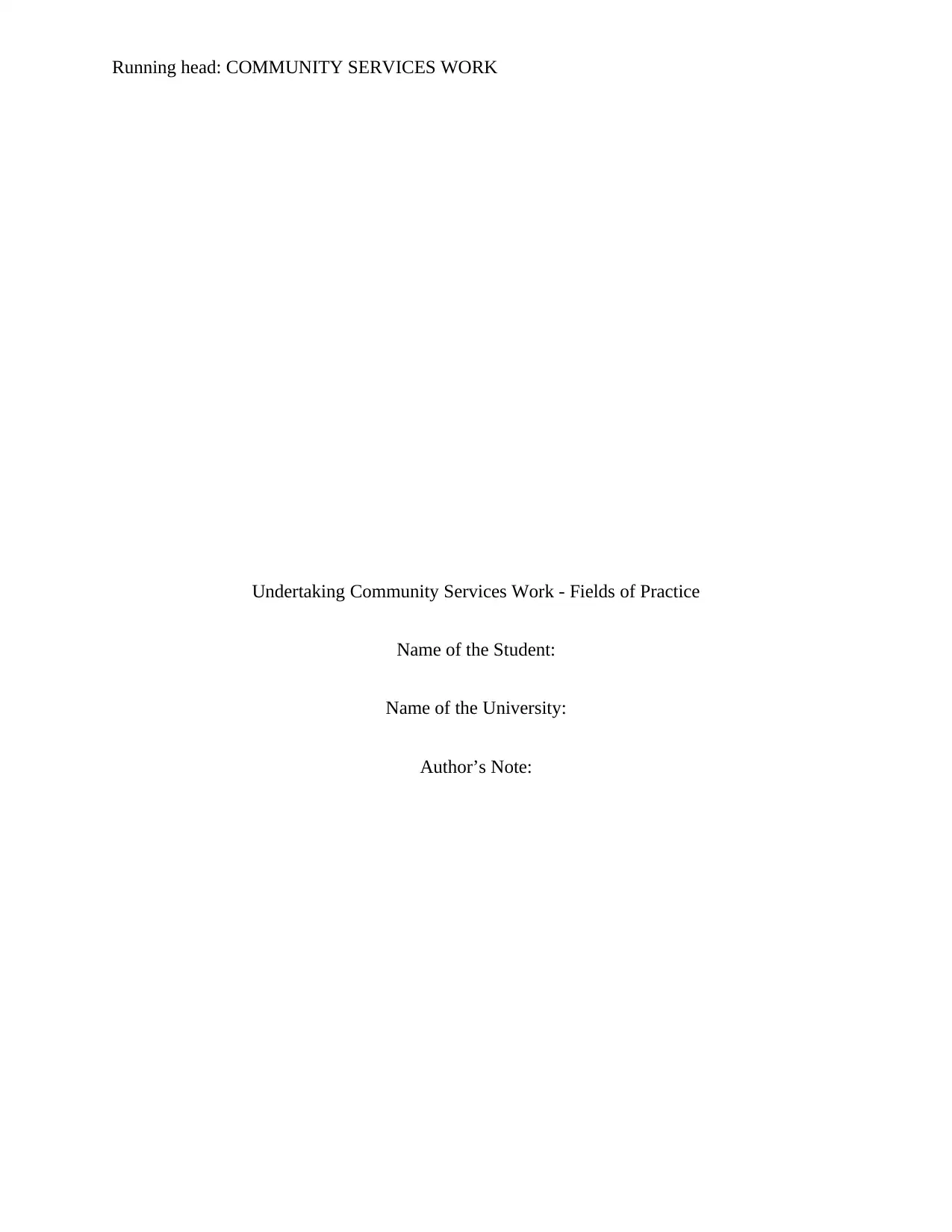
Running head: COMMUNITY SERVICES WORK
Undertaking Community Services Work - Fields of Practice
Name of the Student:
Name of the University:
Author’s Note:
Undertaking Community Services Work - Fields of Practice
Name of the Student:
Name of the University:
Author’s Note:
Paraphrase This Document
Need a fresh take? Get an instant paraphrase of this document with our AI Paraphraser
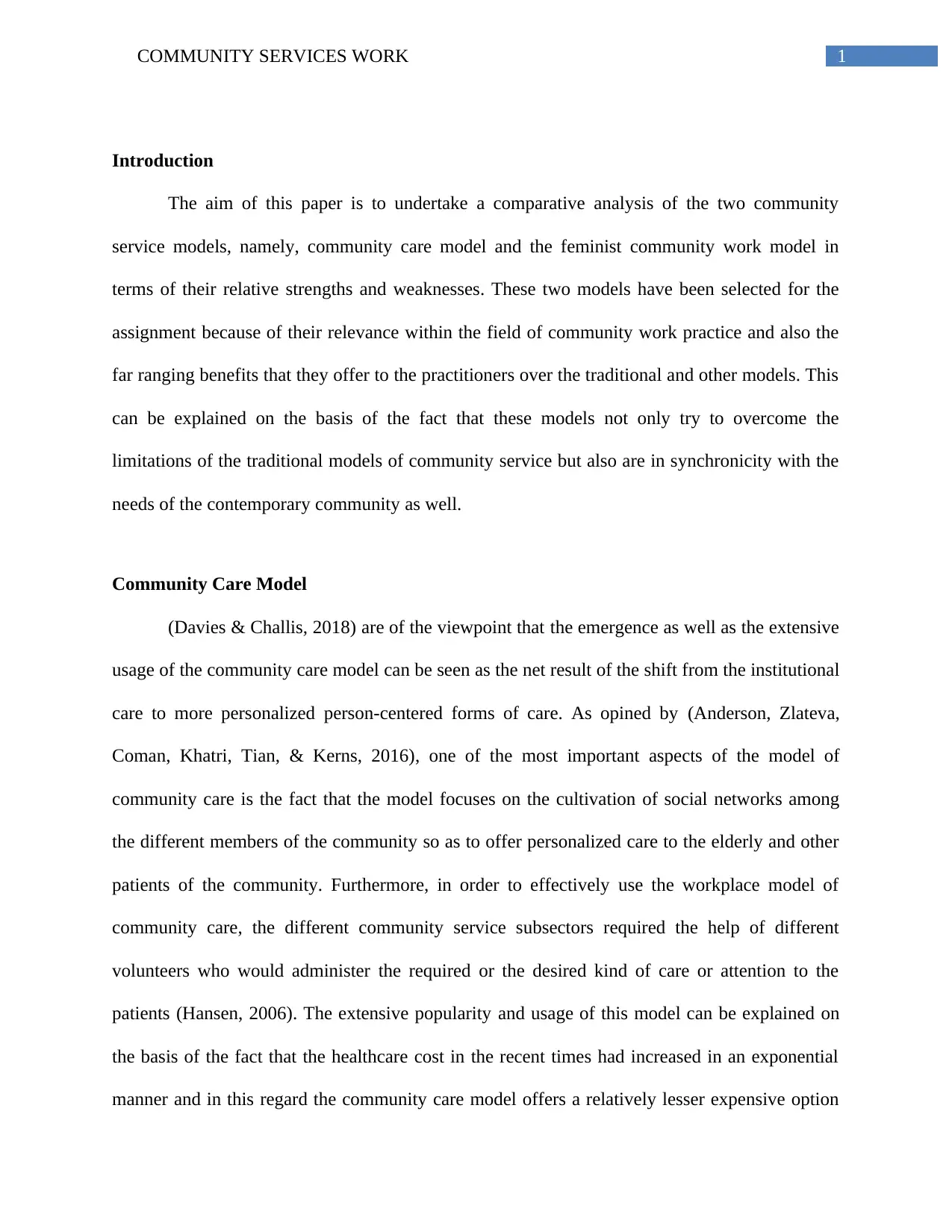
1COMMUNITY SERVICES WORK
Introduction
The aim of this paper is to undertake a comparative analysis of the two community
service models, namely, community care model and the feminist community work model in
terms of their relative strengths and weaknesses. These two models have been selected for the
assignment because of their relevance within the field of community work practice and also the
far ranging benefits that they offer to the practitioners over the traditional and other models. This
can be explained on the basis of the fact that these models not only try to overcome the
limitations of the traditional models of community service but also are in synchronicity with the
needs of the contemporary community as well.
Community Care Model
(Davies & Challis, 2018) are of the viewpoint that the emergence as well as the extensive
usage of the community care model can be seen as the net result of the shift from the institutional
care to more personalized person-centered forms of care. As opined by (Anderson, Zlateva,
Coman, Khatri, Tian, & Kerns, 2016), one of the most important aspects of the model of
community care is the fact that the model focuses on the cultivation of social networks among
the different members of the community so as to offer personalized care to the elderly and other
patients of the community. Furthermore, in order to effectively use the workplace model of
community care, the different community service subsectors required the help of different
volunteers who would administer the required or the desired kind of care or attention to the
patients (Hansen, 2006). The extensive popularity and usage of this model can be explained on
the basis of the fact that the healthcare cost in the recent times had increased in an exponential
manner and in this regard the community care model offers a relatively lesser expensive option
Introduction
The aim of this paper is to undertake a comparative analysis of the two community
service models, namely, community care model and the feminist community work model in
terms of their relative strengths and weaknesses. These two models have been selected for the
assignment because of their relevance within the field of community work practice and also the
far ranging benefits that they offer to the practitioners over the traditional and other models. This
can be explained on the basis of the fact that these models not only try to overcome the
limitations of the traditional models of community service but also are in synchronicity with the
needs of the contemporary community as well.
Community Care Model
(Davies & Challis, 2018) are of the viewpoint that the emergence as well as the extensive
usage of the community care model can be seen as the net result of the shift from the institutional
care to more personalized person-centered forms of care. As opined by (Anderson, Zlateva,
Coman, Khatri, Tian, & Kerns, 2016), one of the most important aspects of the model of
community care is the fact that the model focuses on the cultivation of social networks among
the different members of the community so as to offer personalized care to the elderly and other
patients of the community. Furthermore, in order to effectively use the workplace model of
community care, the different community service subsectors required the help of different
volunteers who would administer the required or the desired kind of care or attention to the
patients (Hansen, 2006). The extensive popularity and usage of this model can be explained on
the basis of the fact that the healthcare cost in the recent times had increased in an exponential
manner and in this regard the community care model offers a relatively lesser expensive option
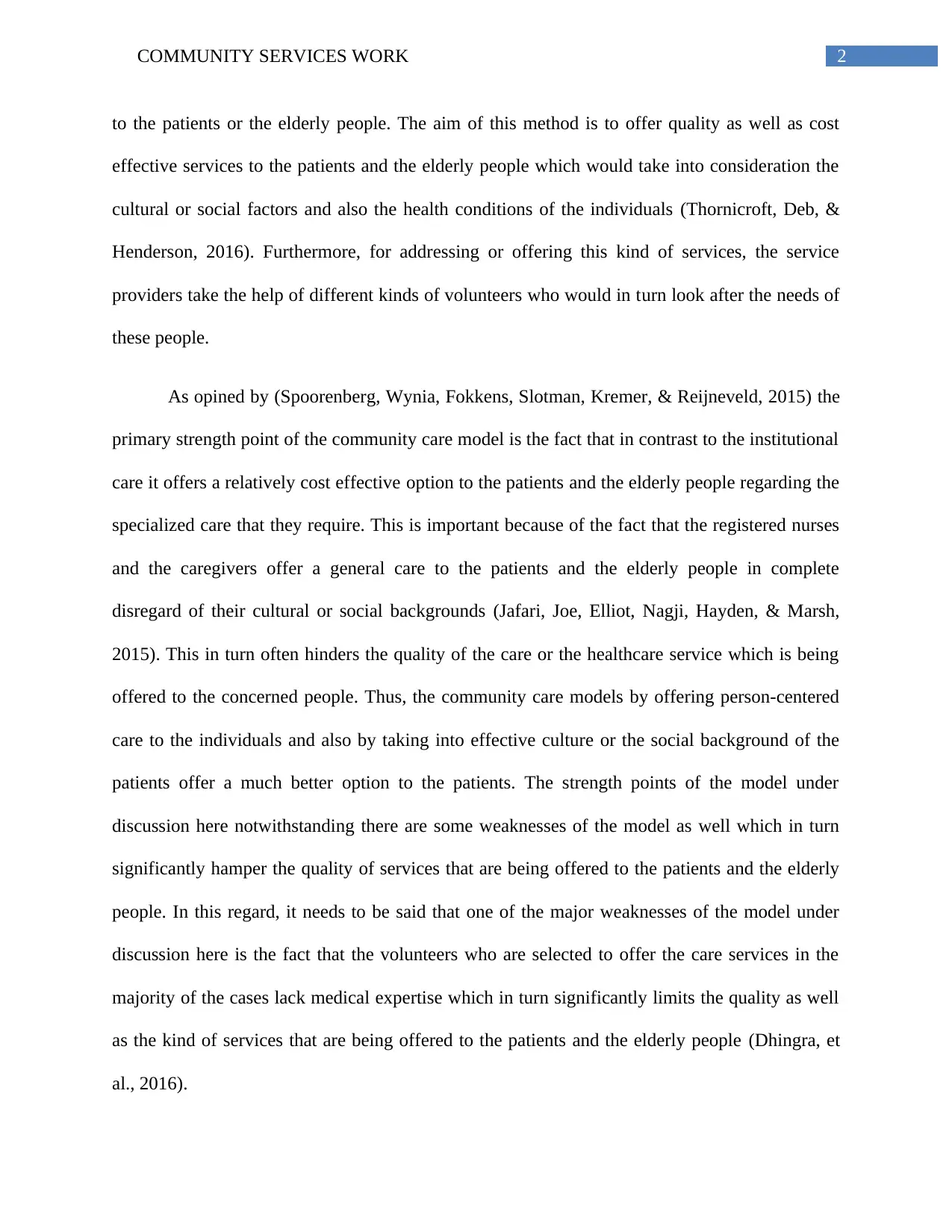
2COMMUNITY SERVICES WORK
to the patients or the elderly people. The aim of this method is to offer quality as well as cost
effective services to the patients and the elderly people which would take into consideration the
cultural or social factors and also the health conditions of the individuals (Thornicroft, Deb, &
Henderson, 2016). Furthermore, for addressing or offering this kind of services, the service
providers take the help of different kinds of volunteers who would in turn look after the needs of
these people.
As opined by (Spoorenberg, Wynia, Fokkens, Slotman, Kremer, & Reijneveld, 2015) the
primary strength point of the community care model is the fact that in contrast to the institutional
care it offers a relatively cost effective option to the patients and the elderly people regarding the
specialized care that they require. This is important because of the fact that the registered nurses
and the caregivers offer a general care to the patients and the elderly people in complete
disregard of their cultural or social backgrounds (Jafari, Joe, Elliot, Nagji, Hayden, & Marsh,
2015). This in turn often hinders the quality of the care or the healthcare service which is being
offered to the concerned people. Thus, the community care models by offering person-centered
care to the individuals and also by taking into effective culture or the social background of the
patients offer a much better option to the patients. The strength points of the model under
discussion here notwithstanding there are some weaknesses of the model as well which in turn
significantly hamper the quality of services that are being offered to the patients and the elderly
people. In this regard, it needs to be said that one of the major weaknesses of the model under
discussion here is the fact that the volunteers who are selected to offer the care services in the
majority of the cases lack medical expertise which in turn significantly limits the quality as well
as the kind of services that are being offered to the patients and the elderly people (Dhingra, et
al., 2016).
to the patients or the elderly people. The aim of this method is to offer quality as well as cost
effective services to the patients and the elderly people which would take into consideration the
cultural or social factors and also the health conditions of the individuals (Thornicroft, Deb, &
Henderson, 2016). Furthermore, for addressing or offering this kind of services, the service
providers take the help of different kinds of volunteers who would in turn look after the needs of
these people.
As opined by (Spoorenberg, Wynia, Fokkens, Slotman, Kremer, & Reijneveld, 2015) the
primary strength point of the community care model is the fact that in contrast to the institutional
care it offers a relatively cost effective option to the patients and the elderly people regarding the
specialized care that they require. This is important because of the fact that the registered nurses
and the caregivers offer a general care to the patients and the elderly people in complete
disregard of their cultural or social backgrounds (Jafari, Joe, Elliot, Nagji, Hayden, & Marsh,
2015). This in turn often hinders the quality of the care or the healthcare service which is being
offered to the concerned people. Thus, the community care models by offering person-centered
care to the individuals and also by taking into effective culture or the social background of the
patients offer a much better option to the patients. The strength points of the model under
discussion here notwithstanding there are some weaknesses of the model as well which in turn
significantly hamper the quality of services that are being offered to the patients and the elderly
people. In this regard, it needs to be said that one of the major weaknesses of the model under
discussion here is the fact that the volunteers who are selected to offer the care services in the
majority of the cases lack medical expertise which in turn significantly limits the quality as well
as the kind of services that are being offered to the patients and the elderly people (Dhingra, et
al., 2016).
⊘ This is a preview!⊘
Do you want full access?
Subscribe today to unlock all pages.

Trusted by 1+ million students worldwide
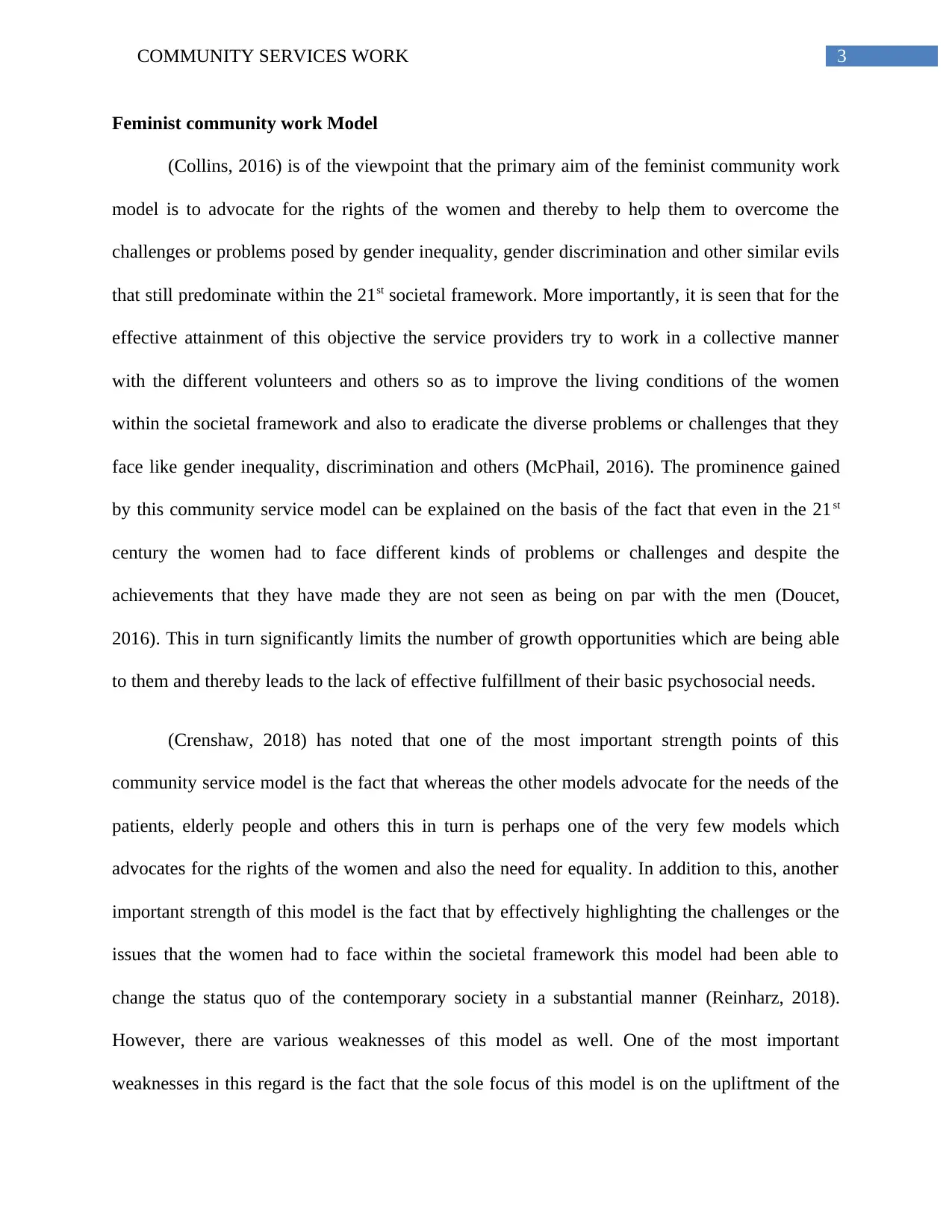
3COMMUNITY SERVICES WORK
Feminist community work Model
(Collins, 2016) is of the viewpoint that the primary aim of the feminist community work
model is to advocate for the rights of the women and thereby to help them to overcome the
challenges or problems posed by gender inequality, gender discrimination and other similar evils
that still predominate within the 21st societal framework. More importantly, it is seen that for the
effective attainment of this objective the service providers try to work in a collective manner
with the different volunteers and others so as to improve the living conditions of the women
within the societal framework and also to eradicate the diverse problems or challenges that they
face like gender inequality, discrimination and others (McPhail, 2016). The prominence gained
by this community service model can be explained on the basis of the fact that even in the 21st
century the women had to face different kinds of problems or challenges and despite the
achievements that they have made they are not seen as being on par with the men (Doucet,
2016). This in turn significantly limits the number of growth opportunities which are being able
to them and thereby leads to the lack of effective fulfillment of their basic psychosocial needs.
(Crenshaw, 2018) has noted that one of the most important strength points of this
community service model is the fact that whereas the other models advocate for the needs of the
patients, elderly people and others this in turn is perhaps one of the very few models which
advocates for the rights of the women and also the need for equality. In addition to this, another
important strength of this model is the fact that by effectively highlighting the challenges or the
issues that the women had to face within the societal framework this model had been able to
change the status quo of the contemporary society in a substantial manner (Reinharz, 2018).
However, there are various weaknesses of this model as well. One of the most important
weaknesses in this regard is the fact that the sole focus of this model is on the upliftment of the
Feminist community work Model
(Collins, 2016) is of the viewpoint that the primary aim of the feminist community work
model is to advocate for the rights of the women and thereby to help them to overcome the
challenges or problems posed by gender inequality, gender discrimination and other similar evils
that still predominate within the 21st societal framework. More importantly, it is seen that for the
effective attainment of this objective the service providers try to work in a collective manner
with the different volunteers and others so as to improve the living conditions of the women
within the societal framework and also to eradicate the diverse problems or challenges that they
face like gender inequality, discrimination and others (McPhail, 2016). The prominence gained
by this community service model can be explained on the basis of the fact that even in the 21st
century the women had to face different kinds of problems or challenges and despite the
achievements that they have made they are not seen as being on par with the men (Doucet,
2016). This in turn significantly limits the number of growth opportunities which are being able
to them and thereby leads to the lack of effective fulfillment of their basic psychosocial needs.
(Crenshaw, 2018) has noted that one of the most important strength points of this
community service model is the fact that whereas the other models advocate for the needs of the
patients, elderly people and others this in turn is perhaps one of the very few models which
advocates for the rights of the women and also the need for equality. In addition to this, another
important strength of this model is the fact that by effectively highlighting the challenges or the
issues that the women had to face within the societal framework this model had been able to
change the status quo of the contemporary society in a substantial manner (Reinharz, 2018).
However, there are various weaknesses of this model as well. One of the most important
weaknesses in this regard is the fact that the sole focus of this model is on the upliftment of the
Paraphrase This Document
Need a fresh take? Get an instant paraphrase of this document with our AI Paraphraser
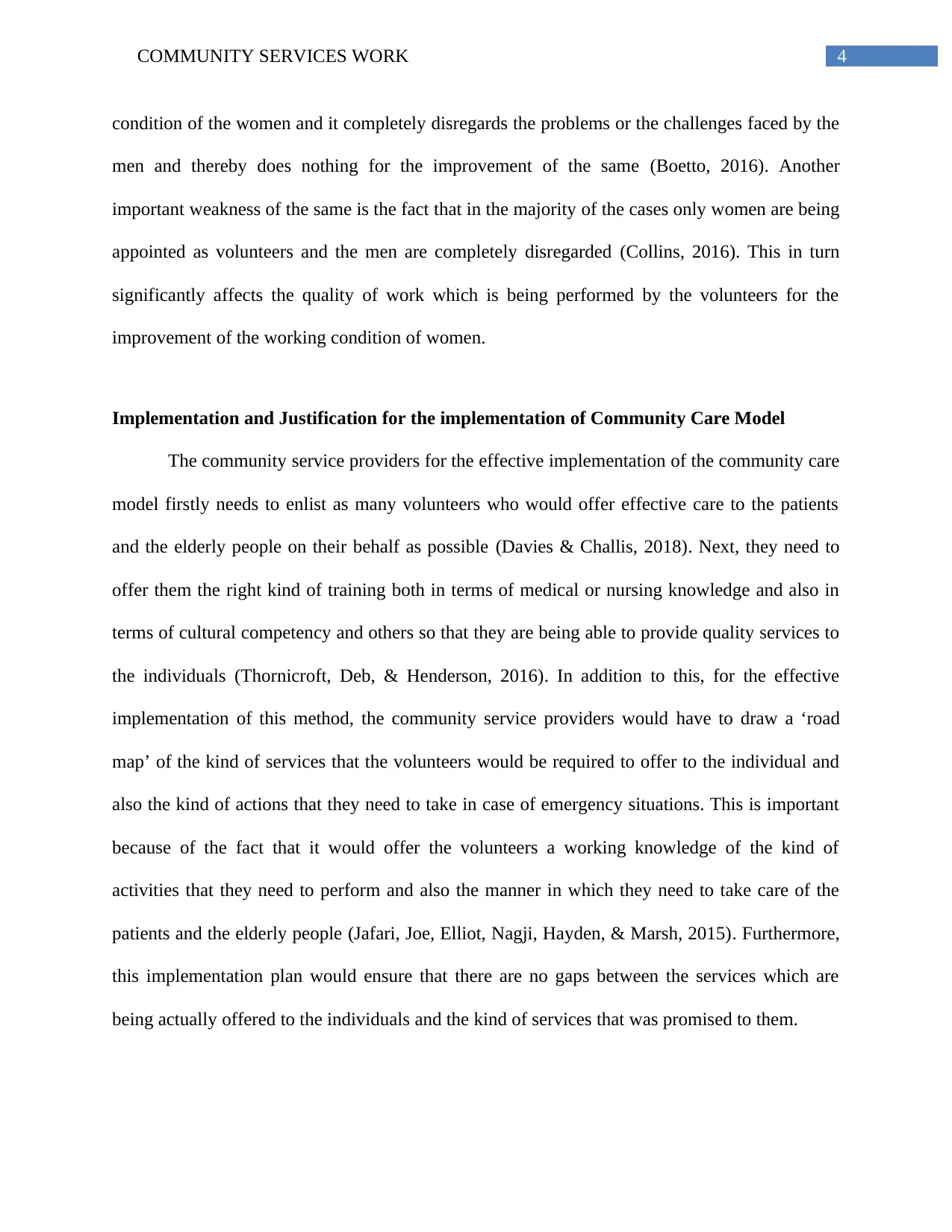
4COMMUNITY SERVICES WORK
condition of the women and it completely disregards the problems or the challenges faced by the
men and thereby does nothing for the improvement of the same (Boetto, 2016). Another
important weakness of the same is the fact that in the majority of the cases only women are being
appointed as volunteers and the men are completely disregarded (Collins, 2016). This in turn
significantly affects the quality of work which is being performed by the volunteers for the
improvement of the working condition of women.
Implementation and Justification for the implementation of Community Care Model
The community service providers for the effective implementation of the community care
model firstly needs to enlist as many volunteers who would offer effective care to the patients
and the elderly people on their behalf as possible (Davies & Challis, 2018). Next, they need to
offer them the right kind of training both in terms of medical or nursing knowledge and also in
terms of cultural competency and others so that they are being able to provide quality services to
the individuals (Thornicroft, Deb, & Henderson, 2016). In addition to this, for the effective
implementation of this method, the community service providers would have to draw a ‘road
map’ of the kind of services that the volunteers would be required to offer to the individual and
also the kind of actions that they need to take in case of emergency situations. This is important
because of the fact that it would offer the volunteers a working knowledge of the kind of
activities that they need to perform and also the manner in which they need to take care of the
patients and the elderly people (Jafari, Joe, Elliot, Nagji, Hayden, & Marsh, 2015). Furthermore,
this implementation plan would ensure that there are no gaps between the services which are
being actually offered to the individuals and the kind of services that was promised to them.
condition of the women and it completely disregards the problems or the challenges faced by the
men and thereby does nothing for the improvement of the same (Boetto, 2016). Another
important weakness of the same is the fact that in the majority of the cases only women are being
appointed as volunteers and the men are completely disregarded (Collins, 2016). This in turn
significantly affects the quality of work which is being performed by the volunteers for the
improvement of the working condition of women.
Implementation and Justification for the implementation of Community Care Model
The community service providers for the effective implementation of the community care
model firstly needs to enlist as many volunteers who would offer effective care to the patients
and the elderly people on their behalf as possible (Davies & Challis, 2018). Next, they need to
offer them the right kind of training both in terms of medical or nursing knowledge and also in
terms of cultural competency and others so that they are being able to provide quality services to
the individuals (Thornicroft, Deb, & Henderson, 2016). In addition to this, for the effective
implementation of this method, the community service providers would have to draw a ‘road
map’ of the kind of services that the volunteers would be required to offer to the individual and
also the kind of actions that they need to take in case of emergency situations. This is important
because of the fact that it would offer the volunteers a working knowledge of the kind of
activities that they need to perform and also the manner in which they need to take care of the
patients and the elderly people (Jafari, Joe, Elliot, Nagji, Hayden, & Marsh, 2015). Furthermore,
this implementation plan would ensure that there are no gaps between the services which are
being actually offered to the individuals and the kind of services that was promised to them.
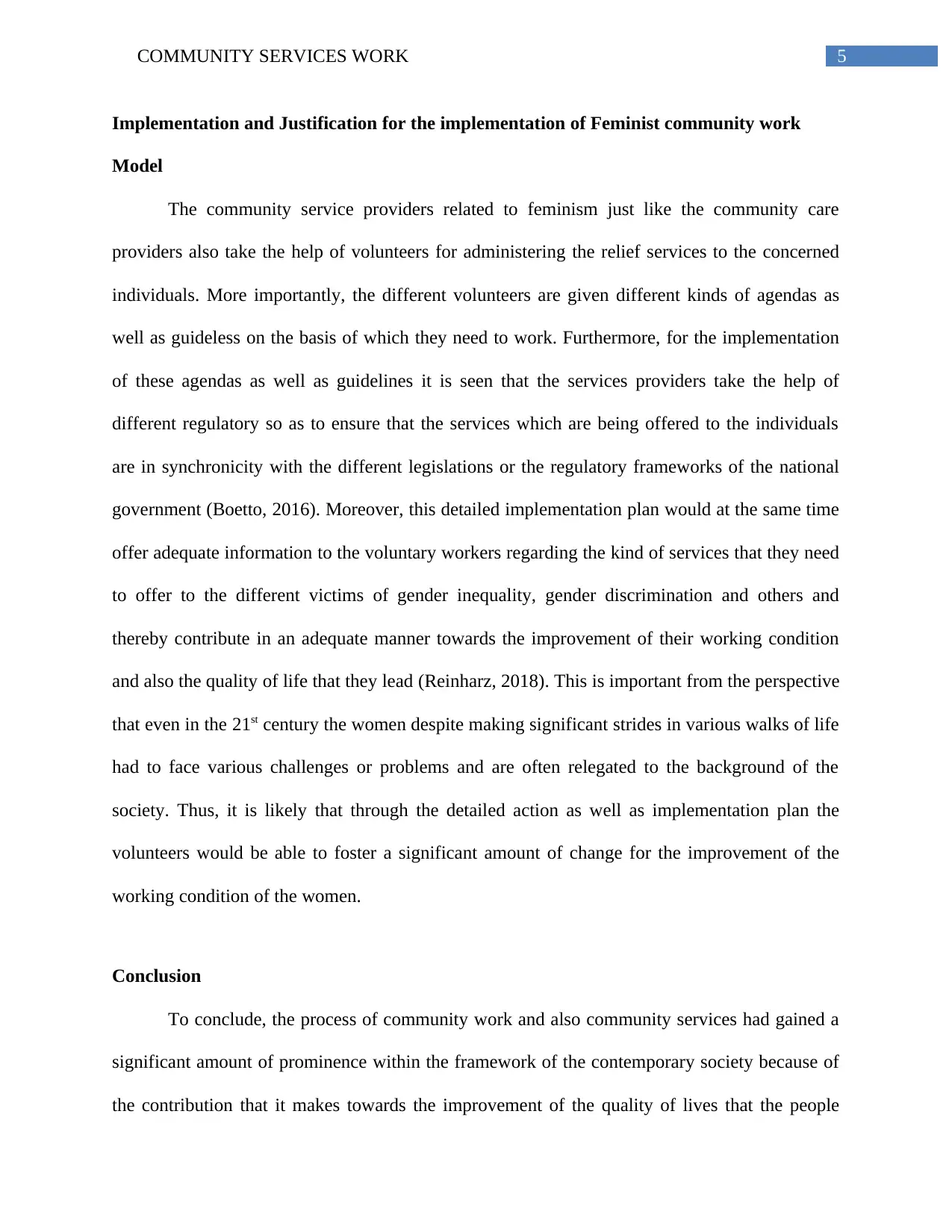
5COMMUNITY SERVICES WORK
Implementation and Justification for the implementation of Feminist community work
Model
The community service providers related to feminism just like the community care
providers also take the help of volunteers for administering the relief services to the concerned
individuals. More importantly, the different volunteers are given different kinds of agendas as
well as guideless on the basis of which they need to work. Furthermore, for the implementation
of these agendas as well as guidelines it is seen that the services providers take the help of
different regulatory so as to ensure that the services which are being offered to the individuals
are in synchronicity with the different legislations or the regulatory frameworks of the national
government (Boetto, 2016). Moreover, this detailed implementation plan would at the same time
offer adequate information to the voluntary workers regarding the kind of services that they need
to offer to the different victims of gender inequality, gender discrimination and others and
thereby contribute in an adequate manner towards the improvement of their working condition
and also the quality of life that they lead (Reinharz, 2018). This is important from the perspective
that even in the 21st century the women despite making significant strides in various walks of life
had to face various challenges or problems and are often relegated to the background of the
society. Thus, it is likely that through the detailed action as well as implementation plan the
volunteers would be able to foster a significant amount of change for the improvement of the
working condition of the women.
Conclusion
To conclude, the process of community work and also community services had gained a
significant amount of prominence within the framework of the contemporary society because of
the contribution that it makes towards the improvement of the quality of lives that the people
Implementation and Justification for the implementation of Feminist community work
Model
The community service providers related to feminism just like the community care
providers also take the help of volunteers for administering the relief services to the concerned
individuals. More importantly, the different volunteers are given different kinds of agendas as
well as guideless on the basis of which they need to work. Furthermore, for the implementation
of these agendas as well as guidelines it is seen that the services providers take the help of
different regulatory so as to ensure that the services which are being offered to the individuals
are in synchronicity with the different legislations or the regulatory frameworks of the national
government (Boetto, 2016). Moreover, this detailed implementation plan would at the same time
offer adequate information to the voluntary workers regarding the kind of services that they need
to offer to the different victims of gender inequality, gender discrimination and others and
thereby contribute in an adequate manner towards the improvement of their working condition
and also the quality of life that they lead (Reinharz, 2018). This is important from the perspective
that even in the 21st century the women despite making significant strides in various walks of life
had to face various challenges or problems and are often relegated to the background of the
society. Thus, it is likely that through the detailed action as well as implementation plan the
volunteers would be able to foster a significant amount of change for the improvement of the
working condition of the women.
Conclusion
To conclude, the process of community work and also community services had gained a
significant amount of prominence within the framework of the contemporary society because of
the contribution that it makes towards the improvement of the quality of lives that the people
⊘ This is a preview!⊘
Do you want full access?
Subscribe today to unlock all pages.

Trusted by 1+ million students worldwide
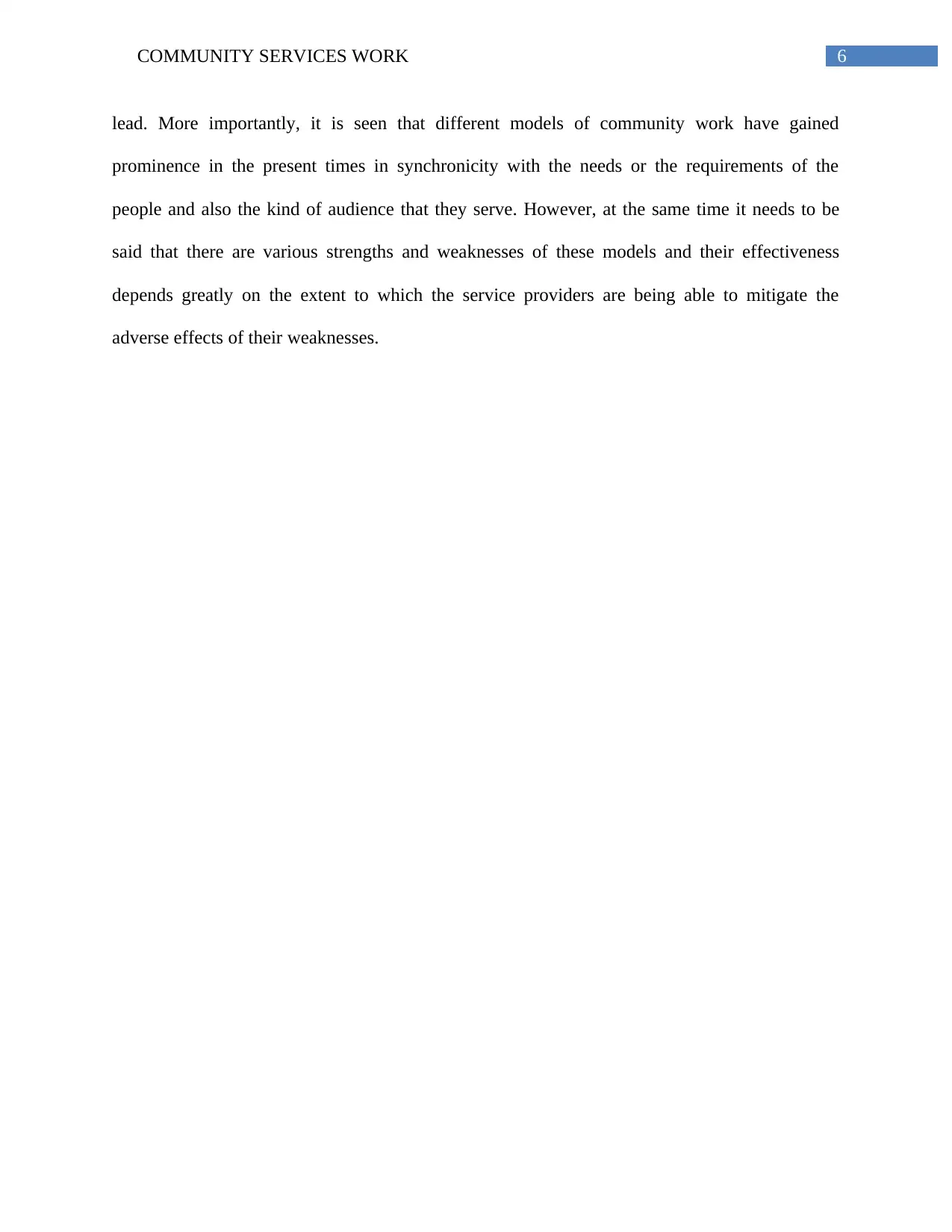
6COMMUNITY SERVICES WORK
lead. More importantly, it is seen that different models of community work have gained
prominence in the present times in synchronicity with the needs or the requirements of the
people and also the kind of audience that they serve. However, at the same time it needs to be
said that there are various strengths and weaknesses of these models and their effectiveness
depends greatly on the extent to which the service providers are being able to mitigate the
adverse effects of their weaknesses.
lead. More importantly, it is seen that different models of community work have gained
prominence in the present times in synchronicity with the needs or the requirements of the
people and also the kind of audience that they serve. However, at the same time it needs to be
said that there are various strengths and weaknesses of these models and their effectiveness
depends greatly on the extent to which the service providers are being able to mitigate the
adverse effects of their weaknesses.
Paraphrase This Document
Need a fresh take? Get an instant paraphrase of this document with our AI Paraphraser
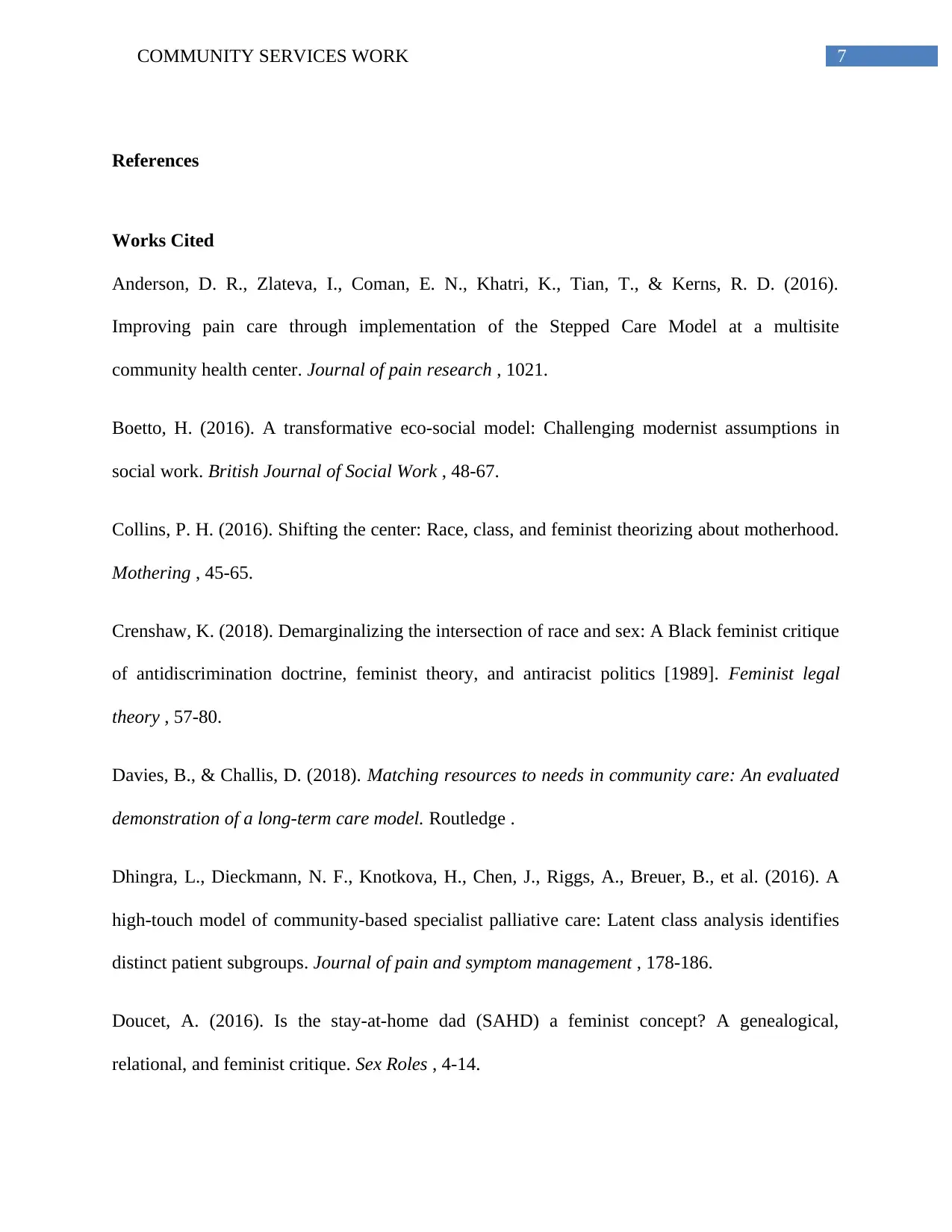
7COMMUNITY SERVICES WORK
References
Works Cited
Anderson, D. R., Zlateva, I., Coman, E. N., Khatri, K., Tian, T., & Kerns, R. D. (2016).
Improving pain care through implementation of the Stepped Care Model at a multisite
community health center. Journal of pain research , 1021.
Boetto, H. (2016). A transformative eco-social model: Challenging modernist assumptions in
social work. British Journal of Social Work , 48-67.
Collins, P. H. (2016). Shifting the center: Race, class, and feminist theorizing about motherhood.
Mothering , 45-65.
Crenshaw, K. (2018). Demarginalizing the intersection of race and sex: A Black feminist critique
of antidiscrimination doctrine, feminist theory, and antiracist politics [1989]. Feminist legal
theory , 57-80.
Davies, B., & Challis, D. (2018). Matching resources to needs in community care: An evaluated
demonstration of a long-term care model. Routledge .
Dhingra, L., Dieckmann, N. F., Knotkova, H., Chen, J., Riggs, A., Breuer, B., et al. (2016). A
high-touch model of community-based specialist palliative care: Latent class analysis identifies
distinct patient subgroups. Journal of pain and symptom management , 178-186.
Doucet, A. (2016). Is the stay-at-home dad (SAHD) a feminist concept? A genealogical,
relational, and feminist critique. Sex Roles , 4-14.
References
Works Cited
Anderson, D. R., Zlateva, I., Coman, E. N., Khatri, K., Tian, T., & Kerns, R. D. (2016).
Improving pain care through implementation of the Stepped Care Model at a multisite
community health center. Journal of pain research , 1021.
Boetto, H. (2016). A transformative eco-social model: Challenging modernist assumptions in
social work. British Journal of Social Work , 48-67.
Collins, P. H. (2016). Shifting the center: Race, class, and feminist theorizing about motherhood.
Mothering , 45-65.
Crenshaw, K. (2018). Demarginalizing the intersection of race and sex: A Black feminist critique
of antidiscrimination doctrine, feminist theory, and antiracist politics [1989]. Feminist legal
theory , 57-80.
Davies, B., & Challis, D. (2018). Matching resources to needs in community care: An evaluated
demonstration of a long-term care model. Routledge .
Dhingra, L., Dieckmann, N. F., Knotkova, H., Chen, J., Riggs, A., Breuer, B., et al. (2016). A
high-touch model of community-based specialist palliative care: Latent class analysis identifies
distinct patient subgroups. Journal of pain and symptom management , 178-186.
Doucet, A. (2016). Is the stay-at-home dad (SAHD) a feminist concept? A genealogical,
relational, and feminist critique. Sex Roles , 4-14.
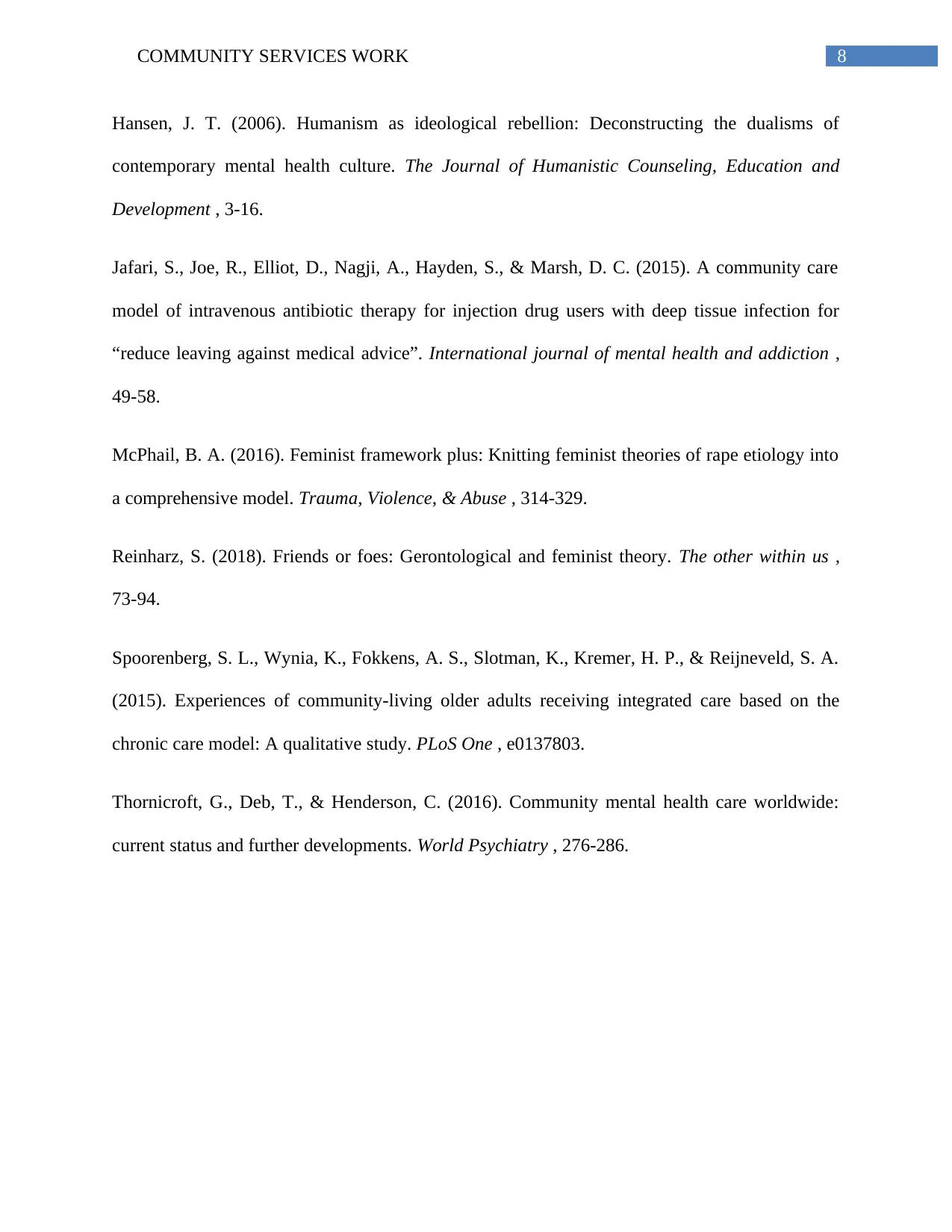
8COMMUNITY SERVICES WORK
Hansen, J. T. (2006). Humanism as ideological rebellion: Deconstructing the dualisms of
contemporary mental health culture. The Journal of Humanistic Counseling, Education and
Development , 3-16.
Jafari, S., Joe, R., Elliot, D., Nagji, A., Hayden, S., & Marsh, D. C. (2015). A community care
model of intravenous antibiotic therapy for injection drug users with deep tissue infection for
“reduce leaving against medical advice”. International journal of mental health and addiction ,
49-58.
McPhail, B. A. (2016). Feminist framework plus: Knitting feminist theories of rape etiology into
a comprehensive model. Trauma, Violence, & Abuse , 314-329.
Reinharz, S. (2018). Friends or foes: Gerontological and feminist theory. The other within us ,
73-94.
Spoorenberg, S. L., Wynia, K., Fokkens, A. S., Slotman, K., Kremer, H. P., & Reijneveld, S. A.
(2015). Experiences of community-living older adults receiving integrated care based on the
chronic care model: A qualitative study. PLoS One , e0137803.
Thornicroft, G., Deb, T., & Henderson, C. (2016). Community mental health care worldwide:
current status and further developments. World Psychiatry , 276-286.
Hansen, J. T. (2006). Humanism as ideological rebellion: Deconstructing the dualisms of
contemporary mental health culture. The Journal of Humanistic Counseling, Education and
Development , 3-16.
Jafari, S., Joe, R., Elliot, D., Nagji, A., Hayden, S., & Marsh, D. C. (2015). A community care
model of intravenous antibiotic therapy for injection drug users with deep tissue infection for
“reduce leaving against medical advice”. International journal of mental health and addiction ,
49-58.
McPhail, B. A. (2016). Feminist framework plus: Knitting feminist theories of rape etiology into
a comprehensive model. Trauma, Violence, & Abuse , 314-329.
Reinharz, S. (2018). Friends or foes: Gerontological and feminist theory. The other within us ,
73-94.
Spoorenberg, S. L., Wynia, K., Fokkens, A. S., Slotman, K., Kremer, H. P., & Reijneveld, S. A.
(2015). Experiences of community-living older adults receiving integrated care based on the
chronic care model: A qualitative study. PLoS One , e0137803.
Thornicroft, G., Deb, T., & Henderson, C. (2016). Community mental health care worldwide:
current status and further developments. World Psychiatry , 276-286.
⊘ This is a preview!⊘
Do you want full access?
Subscribe today to unlock all pages.

Trusted by 1+ million students worldwide
1 out of 9
Related Documents
Your All-in-One AI-Powered Toolkit for Academic Success.
+13062052269
info@desklib.com
Available 24*7 on WhatsApp / Email
![[object Object]](/_next/static/media/star-bottom.7253800d.svg)
Unlock your academic potential
Copyright © 2020–2025 A2Z Services. All Rights Reserved. Developed and managed by ZUCOL.




